Michael's Lase-O-Rama: The Original Star Wars Trilogy Home Video Options
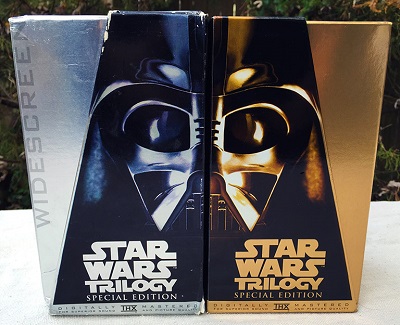
Source: StarWars.com
If you're a Star Wars junkie, or you've spent enough time around one, chances are you've heard something akin to, "If you want the best original, unaltered version of The Trilogy, you've got to get it on laserdisc." Starting in 1997 with the release of the Special Editions, fans who didn't care for the alterations and additions started looking for the best way to see the films they remembered from their childhood -- flaws and all -- in the comfort of their own homes. Chances are, you settled on one of the VHS versions, since they were available literally everywhere. There was a law passed in 1993 that if you were a retail establishment, you needed to offer some version of Star Wars for sale here in the US, or something. I don't know, I was fourteen years old at the time.
With the advent of the internet and its explosion and proliferation throughout the US in the mid-90's, discussion groups and forums were packed to the brim with fans trying to figure out the best way to re-capture the films in their original form. It quickly became 'common knowledge' that watching The Trilogy on anything except the laserdisc format was settling for second-best. That opinion prevails today, and I'm one of the people proliferating it.
The simple fact is that if you want classic Star Wars in the best video and audio quality, the way you remember it as a kid, don't want to spend the time/bandwidth comparing gigabytes' worth of fan edits and de-specialized editions (which are dubious in their legality at best), and weren't satisfied with the "bonus discs" from the 2006 DVD boxed set in their 4:3 non-anamorphic letterbox transfer and two-channel Stereo mix -- and who could blame you? -- then you've probably considered picking up the laserdiscs and a player at some point.
If so, then go strap yourselves in; I'm going to make the jump to geek speed. We're in for a long trip, so use the HoloChess table if you get bored. Keeping in mind that I live in the USA and am unfamiliar with most non-NTSC video formats, and thus am writing for a similar audience, this is everything you never knew you needed to know about...
The Original Star Wars Trilogy on Home Video
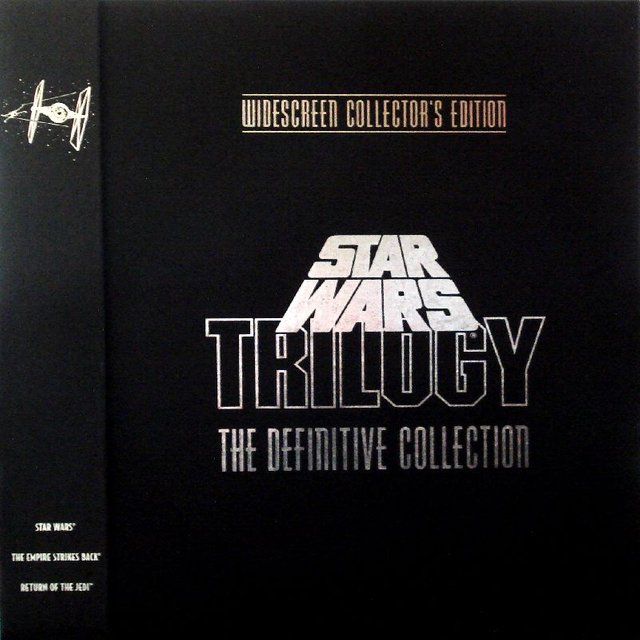
Source: The Laser Disc Database
If you came here looking for the easy answer to the question, and money is no object, then this image is all you need. Go right ahead and hit up eBay for a copy of The Star Wars Trilogy Definitive Collection, and call it a day. These are 2.35:1 widescreen letterboxed versions of the films, remixed to THX standards with a full 5.1 Dolby Surround digital audio track, and a separate Analog stereo track offering up occasional trivia, tidbits, and commentary from people associated with the films' production. It comes in that stunning black display case, and includes a copy of the book "George Lucas, The Creative Impulse" for those times when you want to read instead of watching a Star Wars movie, along with a small insert breaking down chapter listings, commentary notes, and supplemental materials on a disc-by-disc basis.
Each film fills three whole discs, for a total of six sides per movie. Five sides are utilized for the films themselves, while the sixth side contains supplementary materials like original television teasers, theatrical trailers, music videos, and other goodies. The reason so many discs are used is that this set utilizes the CAV, or Constant Angular Velocity, encoding format. This provides a slightly better picture quality in exchange for less time per side of the disc. The down side is that you have to get up off the couch at least twice, even if you have a player that will auto-play the second side without needing to manually flip it. The upside is the aforementioned better video quality, along with the ability to pause and inspect the film frame-by-frame if you desire, which is something you normally can't do with CLV, or Constant Linear Velocity, discs.
The real downside to this behemoth is the price. Brand new in 1993 this sucker retailed for $250 in the US market, and time hasn't diminished that price much, as the desire for it even twenty-five years later outstrips the supply. Expect to fork over somewhere in the neighborhood of $150-200 to add this to your library, and if you buy it online expect your wallet to take another hit on shipping charges: between the case, the hardcover, the liner notes, and nine laserdiscs all in their own protective sleeves and sleek black cardboard holders, this thing weighs enough to almost make it more economical to drive across the country to pick it up yourself, to say nothing about what international shipping rates will look like.
So if you want the one-and-done method, there you have it. Those unwilling to fork over the equivalent of a car payment for the sake of owning a giant tribute to a dead medium, on the other hand, should look elsewhere. Here's a sampling of what you're likely to find in the wild once you begin your Star Wars laserdisc hunt in earnest.
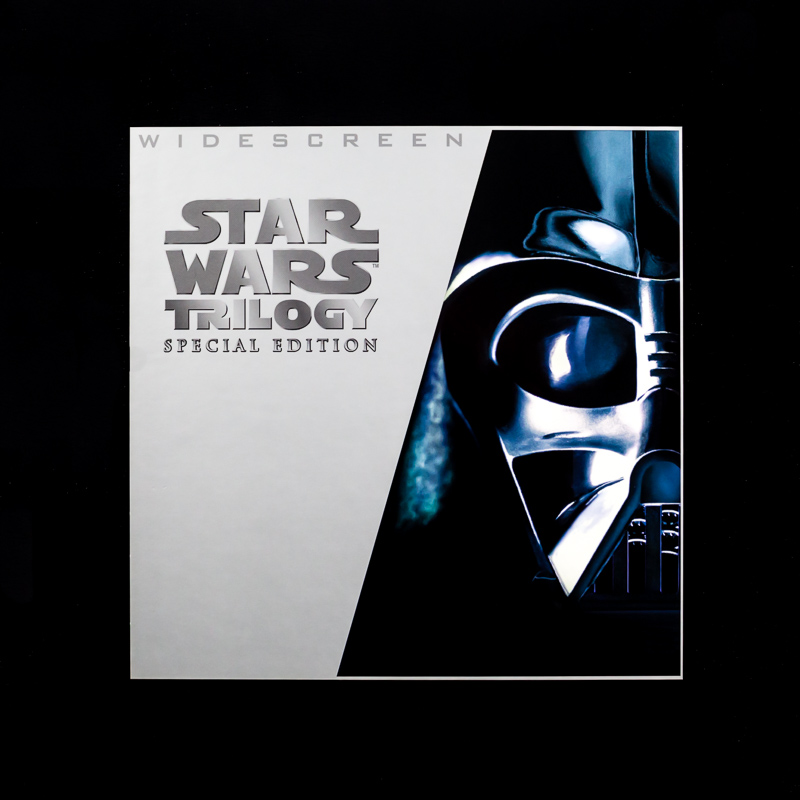
Source: The Laser Disc Database
This is the other version of the trilogy to appear in a big, black box. This beast was $125 when it was released in 1997, but eagle-eyed readers have already identified the problem with this set: it's the Special Edition. While this is a gorgeous box with its black/silver motif, it would look beautiful on the shelf, and the picture and sound are superior to even the Definitive Collection mentioned earlier, these aren't the discs you're looking for.
If you want the unaltered trilogy, don't buy this. If you want the Special Editions in their theatrically-released format, then just buy the gold box DVDs and save yourself the time, money, and headache of adding another component to your home theater setup. For collectors only. All others: move along...move along...
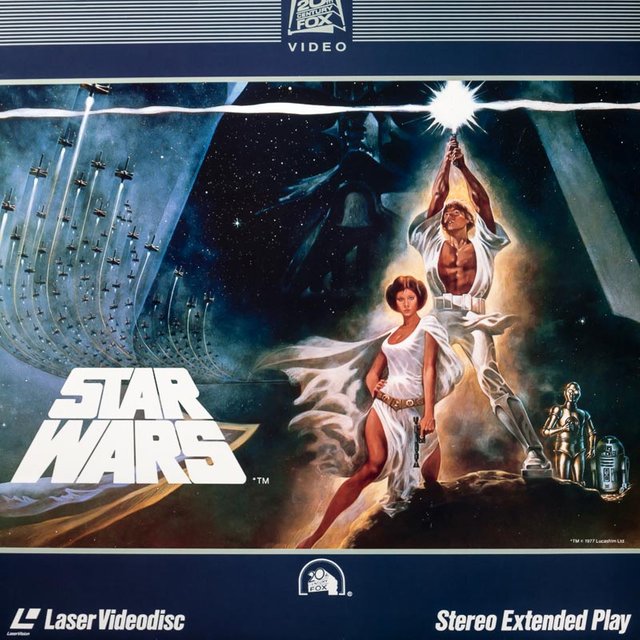
Source: The Laser Disc Database
This is the very first version of the first film released on LD in 1982. Since nobody had a widescreen television back then, this is a pan-and-scan (full screen) version. Video and audio quality are superior to the VHS formats released at the same time, but with the pan-and-scan 1.33:1 aspect ratio, you're losing half the visual imagery of every shot. It's also CLV format, so you won't be able to frame-by-frame on most players. If you're looking to recapture the joys of youth, where you watched this at home with your nose plastered to the screen and your parents yelling at you to back up before you burned out your retinas, that's about all this version is good for.
That said, you probably want to avoid that one and its brother:
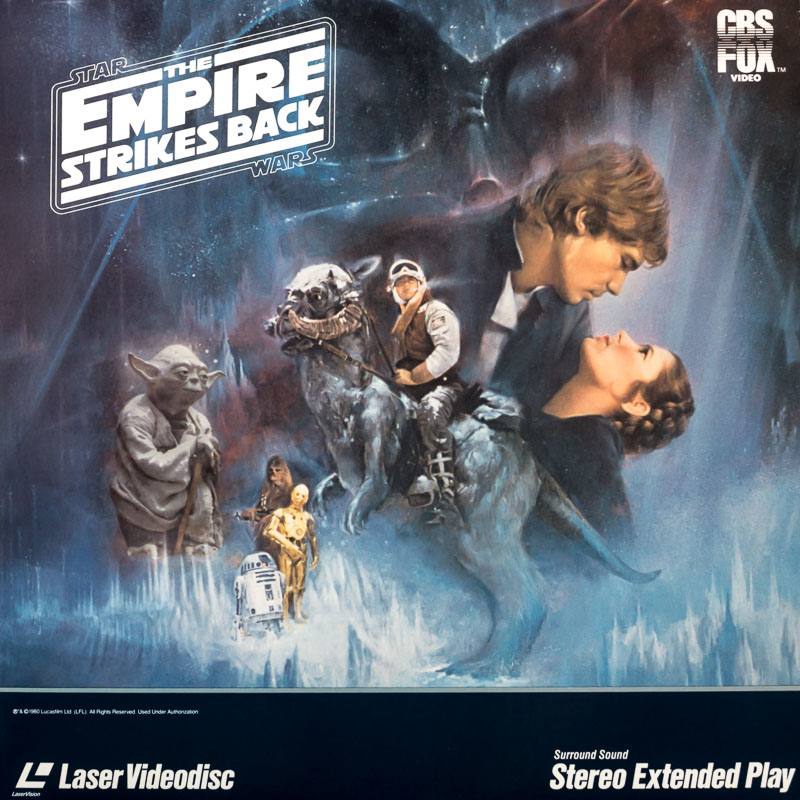
Source: The Laser Disc Database
Laserdiscs in CLV format can hold 60 minutes of video per side, but The Empire Strikes Back runs 124 minutes, and A New Hope clocks in at 121. A quick bit of mental math reveals the most a CLV disc can hold is 120 minutes, but the running time on the jackets reveals both pictures run for 119 minutes. What happened? Did they just slice out sixty seconds of A New Hope and five minutes of The Empire Strikes Back and hope we wouldn't notice?
No, but I almost wish they had. Rather than doing the sensible thing and releasing the movies on two discs (the path they had to take with Return of the Jedi thanks to its 132-minute pace), the nerf-herders responsible for the laserdisc transfer just...sped the films up.
It's imperceptible with A New Hope, but if you're at all familiar with any other version of The Empire Strikes Back, the incorrect timing is impossible not to hear. This also results in audio with a slightly higher pitch, and some ghosting where one frame bleeds into another. The result is neither video nor audio matching the original theatrical edition, making these, in my opinion, the worst releases of an original trilogy film available for home viewing. Only the CED VideoDisc release tops this one for sheer awfulness. These should have been sent to the spice mines of Kessel (or smashed into who knows what). Avoid at all costs.
If for some reason you're dead-set on adding a pan-and-scan version of the first two films to your library, look for these:
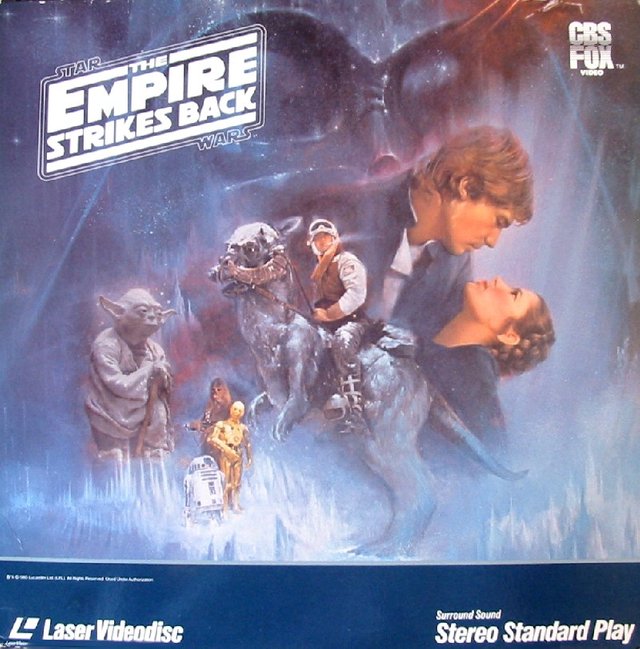
Source: The Laser Disc Database
Note the 'Standard Play' listed on the cover, and the blue bar running across the bottom? This three-disc release is in CAV format, and not time compressed, meaning you get the full 124-minute play time for Empire with none of the sped-up time compression effects seen on the Extended Play discs. All three films were released in pan-and-scan format in Standard Play with this artwork, so if you're watching on a smaller television or monitor where widescreen transfers are less-desireable, this here's your full screen aspect ratio set of choice.
Subsequent releases of these on the CBS/FOX label with the same cover artwork came out in 1989 in widescreen, letterboxed format:
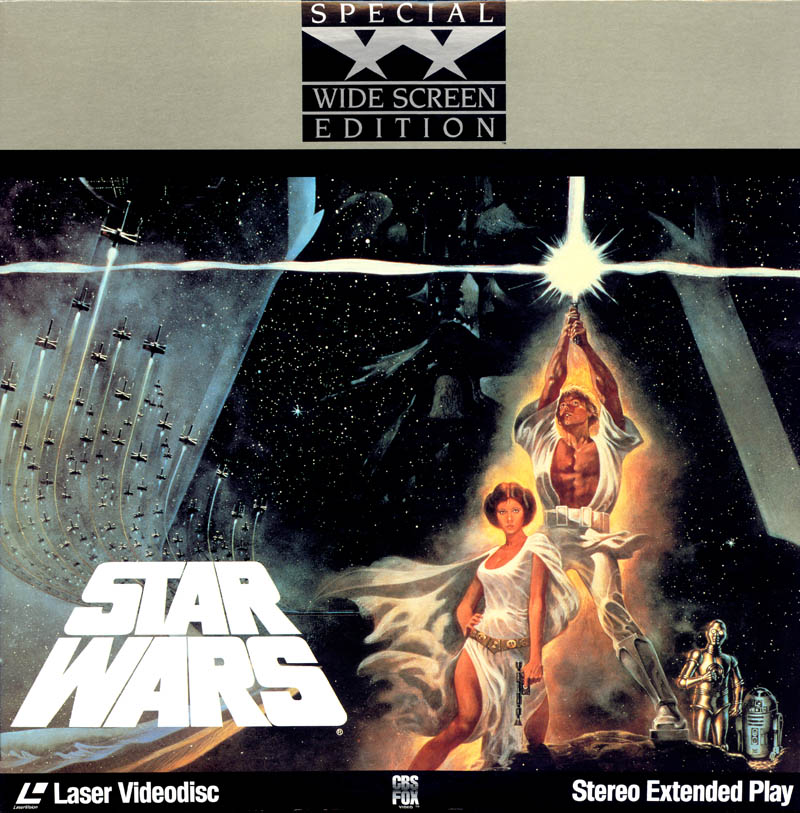
Source: The Laser Disc Database
They're all two-disc CLV releases, meaning there was no need for time compression on any of the films, and were encoded with Dolby Surround giving them superior audio quality to the single-disc versions. They feature a lovely gatefold cover, with information about the making of the movies and a number of screenshots and promotional images, and as noted, they carry a widescreen aspect ratio. These will be pricier than the pan-and-scan Extended Play versions, but if you're looking for the cheapest widescreen laserdisc experience, it'll work. It'll work!
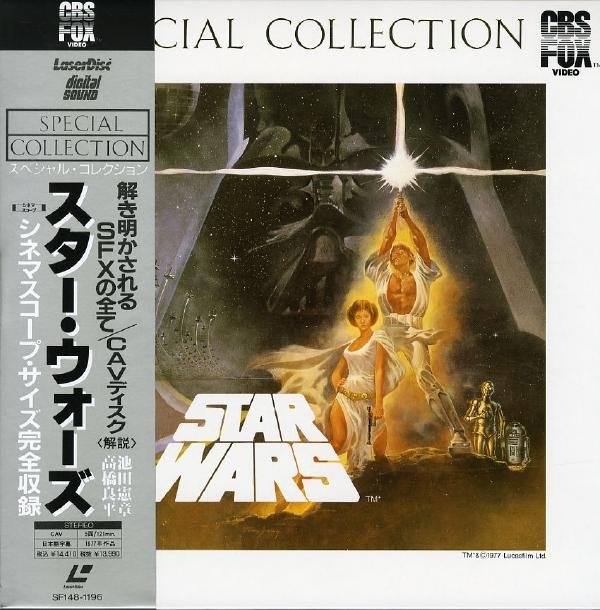
Source: The Laser Disc Database
It's highly unlikely you'll find these white-sleeved Japanese pressings out in the wild, but if you do and the price is right, consider investing in them. They are widescreen, presented in a 2.33:1 aspect ratio, with the video elevated slightly off-center to accommodate the hard-coded Japanese subtitles. They're CAV format like the Definitive Collection, so every movie takes up five sides of three discs, but the sound and picture quality are superior to the CLV widescreen editions released by CBS/Fox here in the US, and you can frame-by-frame to your heart's content.
There's one downside to owning these that you won't notice until you reach certain scenes: all the alien dialog subtitled in English in the US releases is missing those subtitles in this version -- it's only subtitled in Japanese! This makes it perfect for @sakurasui, but rather silly for everyone else. :D
If you've watched these films religiously, you can quote the aliens' subtitled words in your sleep and most of what they're saying comes through in context anyway, but it's most noticeable in Return of the Jedi given all the dialog Jabba the Hutt had. If this doesn't bother you, and you stumble across these in a thrift store or pawn shop for a decent price, grab them up. Of course, the odds of that happening outside of Japan are about 3,720 to 1, so, you know, don't rely on this method exclusively.
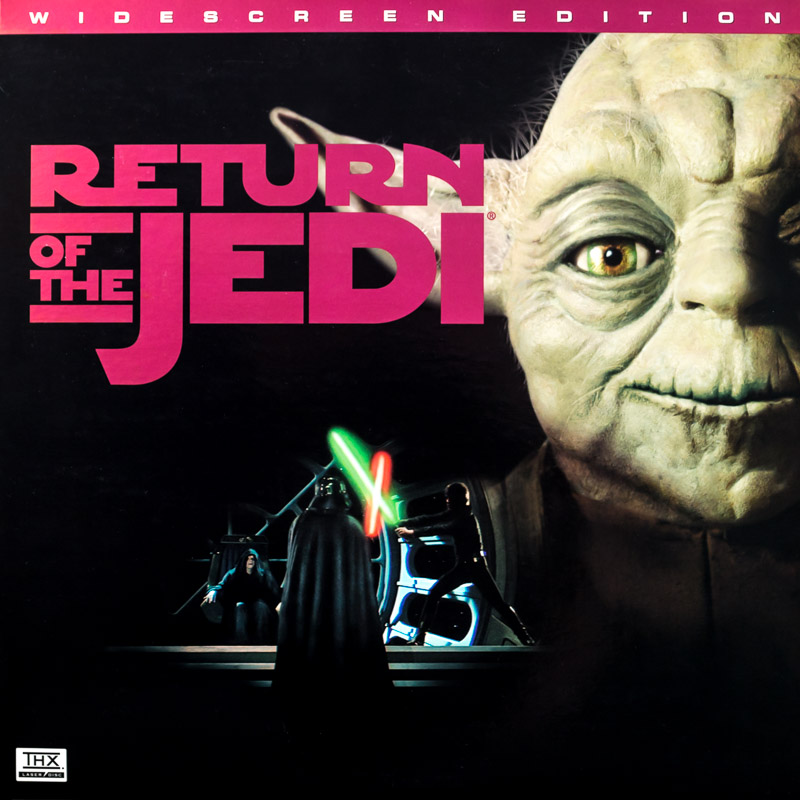
Source: The Laser Disc Database
Finally we come to the iconic 'Faces' release of the trilogy. Released in 1995, just as Lucas was beginning to go back and add his enhancements, stickers on the front of these laserdisc and VHS releases proclaimed this as your last chance to own the original trilogy. These are widescreen letterbox transfers with beautiful THX and Dolby Surround audio mixes, released on 3 discs in CLV format, and if you can't get your hands on the CAV "Definitive Collection" boxed set, these are absolutely the next best thing if you're willing to sacrifice the slightly better video quality.
As an added bonus, the final chapter of each film concludes with 1/3rd of an interview George Lucas did with TV and film reviewer Leonard Maltin (collect all three discs to get the full interview!). The parts aren't that long, only 6-7 minutes each, for a total run time of about twenty minutes. You can see this interview on the internet and on the VHS tapes as well, so it's hardly worth shelling out serious cash to get them just for this, but it's a nice addition anyway, and it's something that doesn't appear in the Definitive Collection.
Knowing that the original trilogy is available on laser disc, and considered by many to be the best (legal) way to watch the films as we remember them from our childhood, you still have to do your homework and make sure your desires match what you're paying for. Knowing which releases are full screen, which are widescreen, which are time-compressed, and the difference between CLV and CAV disc formats means you can make the most sensible nostalgic choice and avoid the dross. I hope, if you've been considering adding Star Wars to your laser disc library, this post helped you decide which version was best for you.
By all means, sound off in the comments if you have a particular favorite, if I overlooked a certain version, or made a mistake. While I love laserdiscs, I've only been collecting for about ten years and still have plenty to learn.
Thanks for reading, and of course, may the Force be with you.
ui... Star Wars community seems to be huge... So many votes! I'm happy for you 😊 @peekbit
Which is your favorite movie of the original trilogy? Mine is the less than popular Return of the Jedi.
While I love Jedi, my heart will always belong to the original Star Wars. :)
Me too! Watched the original Star Wars with my dad before he passed. He was a huge fan. :) God bless.
Jedi was always my favorite as well. It probably depends partly on what age you were when you saw them. Jedi is the first one I can clearly remember seeing in the theater though I know I was taken to see them all.
Return of the Jedi was the only one of the original trilogy I saw in theaters. I was technically present for Star Wars, but only by virtue of my mother's pregnancy, and I was too young to see ESB when it came out.
Thanks for the write up.
LaserDiscs blew my mind when I first saw them.
My pleasure, @lionsuit! Glad you enjoyed it. LaserDiscs are pretty amazing, aren't they? :)
Yes, I remember I was in class, and the teacher pulled the huge disc out from its sleeve. I was thinking, "Let's do this."
It was probably on a 240p equivalent tv or something. Ha.
The laserdisc version is by far the most intriguing!
I had a laser disc player for a while but I never owned any of these. Don't laser discs decay over time? I know ultimately everything does but I though the "bit rot" effect for laserdiscs was worse than issues more modern media like DVDs have.
Since laserdisc is an analog format like vinyl, there's no such thing as 'bit rot' with them the way there is with other forms of digital media.
The problem laserdiscs can suffer from is called 'laser rot', though this has nothing to do with the laser rotting the medium, and everything to do with how they're stored by the end user, and how they were manufactured initially. Laser rot is a problem endemic to some discs, and virtually unseen on others, where imperfections in the mastering process result in the destruction of the metallic later that holds the video information.
Minor rot shows up as minor glitches (brief flashes of white in one particular area of the picture, skipped frames, and audio problems). Since laserdiscs are analog, however, the player will just keep on playing despite the damage, while a DVD damaged in a similar fashion will attempt error correction but it can freeze if the disc is too unreadable. Films are still watchable in this state.
Major rot, on the other hand, will completely destroy the utility of a disc, with large-scale frame drops and skips, missing audio information, and massive video degradation to the point of unwatchability. Rot resulting from a manufacturing defect is nearly unavoidable: if a given disc was pressed at a certain time at a certain plant, it's almost guaranteed to develop the problem. Early laserdiscs were first pressed in the US at a plant set up in an old furniture manufacturing facility, which was not cleaned and sterilized prior to equipment installation. As a result, nearly every disc that left that facility either shipped in a defective state, or developed one soon after. These discs are nearly impossible to find in anything approaching a playable state today.
This is a quick 1.5 minute long example of what minor, serious, and severe rot does to a disc. :)
Bit rot, laser rot..same thing :). I just remember having an Indiana Jones laserdisc that was pretty much unwatchable. It was like watching a TV station that you just barely had a signal for. Mostly snow.
Hi modernzorker,
LEARN MORE: Join Curie on Discord chat and check the pinned notes (pushpin icon, upper right) for Curie Whitepaper, FAQ and most recent guidelines.